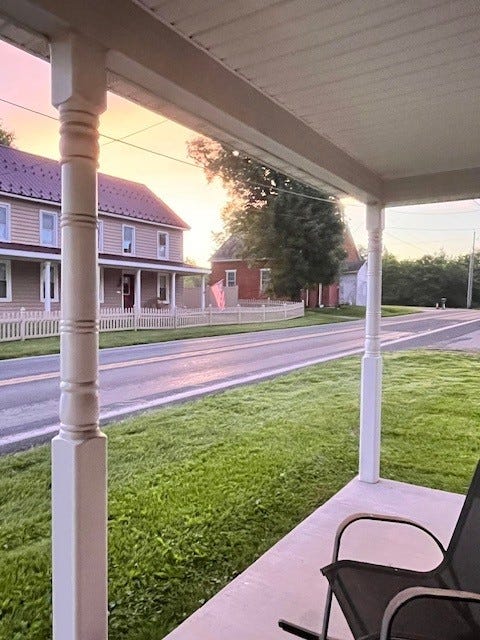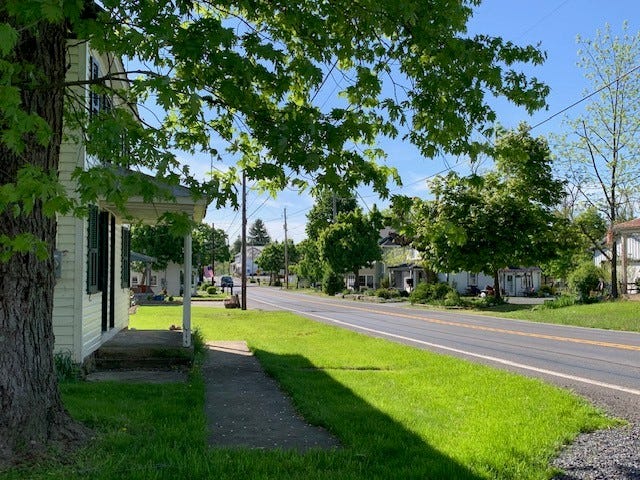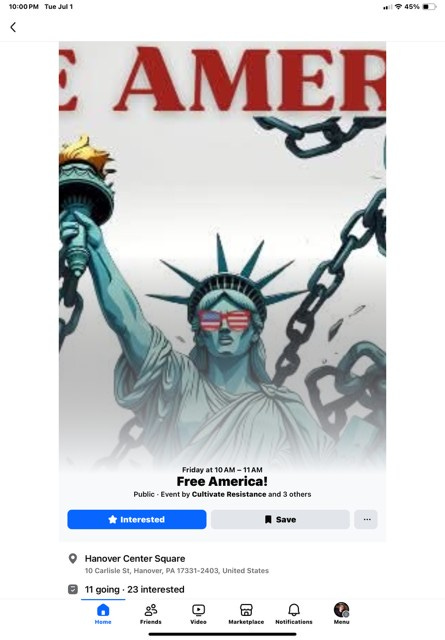Gettysburg: Outside the battlefield
The Gettysburg Campaign affected far more than residents of Gettysburg proper. Heroes existed outside the borough’s immediate city limits.

Today marks the mid-point of the annual remembrances of the Gettysburg Campaign, July 1-3, 1863. Reenactors will reenact Pickett’s Charge. The town will be full of locals dressed in nineteenth-century garb. All the stores and gift shops and restaurants will be open, even on their quiet days. And it will be next to impossible to find a hotel room or AirBNB at a reasonable rate.
Town, battlefield, and Visitor’s Center will be full to overflowing. I participated in the celebrations my first year here (2022) and quickly learned it’s better to explore on days not named July 1, July 2, or July 3. July 4 is also crazy busy in Gettysburg, not because anyone celebrates the retreat of confederate (CSA) forces. Although that would be a great reason to celebrate! But the town’s Fourth of July party is a major event.
If you find yourself here at a time when it’s next to miserable to be out and about —those double-decker tour buses are a real killjoy if you’re doing the National Park Service’s excellent auto-tour of the battlefield — don’t despair.
The reason General Lee thought little old Gettysburg made a good target? The ten roads that intersected (and intersect) in this town. I’ll do separate posts later about those “ten roads,” because May and June 2022, I drove almost all of them. Yes, I will eventually finish the last three. But those first seven opened my eyes to the greater story that exists all around the central battlefield, yet not part of it.
I live in one of those places, not one of the ten roads, but perhaps the most important road in the area prior to 1800. What is now Pennsylvania Route 394 was once The Road That Connected Philadelphia To Carlisle. President George Washington traveled the road directly in front of my house when he put down the Whiskey Rebellion in Carlisle. On his return trip, he had his horse shod a quarter-mile from my home.
The little Presbyterian congregation in town predates the American Revolution by a good two decades, although the larger sanctuary wouldn’t be completed until around 1787. Its graveyard contains headstones of soldiers killed in battle and veterans from the American Revolution, Civil War, and (sadly) far too many wars thereafter. Those Presbyterians sheltered a freed slave who had been kidnapped by her “owner’s” heirs. When she made her way back to freedom in Pennsylvania, those Presbyterians kept her safe.
The Road That Connected Philadelphia To Carlisle became less important in 1800. When Pennsylvania, true to its hub-and-spoke British planning model, decided to split York County and establish Adams County, the county seat was supposed to be my village of Hunterstown. But Mr. Gettys told state fathers that if they would make his tiny Johnny-come-lately hamlet the county seat, he would personally donate funds for the jail, county courthouse, and “quit rents” for the two-hundred parcels of land he owned. As has been the case forever, money talked. Gettysburg became the new county seat. To the detriment of Hunterstown.
On this day one hundred and sixty-two years ago, Hunterstown was the site of a furiously-fought battle. This post will not cover the Battle of Hunterstown, as I’ve heard so much from my neighbors and other locals about it that I still am working on sorting out fact from fiction.
Suffice it to say, the Battle of Hunterstown served a larger purpose in the Gettysburg Campaign than the trifles of ink usually dedicated to it. Had the Union Army not fought to a “draw” here, CSA reinforcements would have reached the main battlefield. The outcome could have been much different on July 3 had that happened.
The Battle of Hunterstown also exemplifies how messy and complicated history can be, when told correctly, when hewing to truth. Because one of the heroes of the battle that was fought on the street in front of my house and around the corner in the cornfields was none other than Brigadier General George Armstrong Custer. Yes, that Custer. His role in saving the union in 1863 should be writ large.
The Taughenbaugh family that owned the property where I now live will feature prominently in that “Battle of Hunterstown” post. It is one of the few families that no longer lives in Hunterstown. I have to be careful what I say to friends and neighbors in this little town. Everyone’s related. And most of them are related to, or worked for, the Kammerers, the family that owns the cornfields behind my home.
Hunterstown is not the only non-Gettysburg place that is worthy of exploration when Gettysburg proper is too crowded. Hanover too, that Black Rose City that is mostly industrial and commercial these days, played a significant role in the Gettysburg campaign. Their courageous telegraph operator rescued Hanover’s telegraph equipment from the Confederates at great peril to his own life. Without that cutting edge technology, United States military would not have been able to call for reinforcements in time.
As a somewhat-pedantic historian, I like these little nuggets, these oddly-shaped pieces of the puzzle. The if-thens of history, the what-ifs, the only-becauses — those fascinate me. When you come to Gettysburg, carve out a bit of time for these nuggets.
As I look out my front door and remember what the Taughenbaughs experienced, the “skirmish” of July 2, 1863 is very real. I live in relative peace and quiet, despite the loud tractors and sprayers that rumble down my road at 5 a.m. come summer, and the occasional disquieting incidents like a (former) squatter neighbor or a car that parks —on the road! — in front of my house after dark, without moving.
Despite such infrequent incidents, I don’t know the terror of CSA soldiers rampaging through town, of Custer’s near-death experience here, of CSA corpses abandoned on the road with townspeople left to deal with the stinking bodies of the enemy.
These stories are worth your time when you visit Gettysburg. Of course, do the big stuff first — the battlefield, Dobbin House!, the town square. But remember that the Gettysburg Campaign affected far more than residents of Gettysburg proper. Heroes existed outside the borough’s immediate city limits.
Heroes named Taughenbaugh, McCreary, Goldsborough, Plank, Little, Grass, Shriver, Kammerer, and of course, Tate (where Washington’s horse was shod). Their names should be remembered too.
Postscript: If you plan to be in Gettysburg on July 5, and every Saturday for a long time to come, consider joining the one-hour permitted protest on the square at noon. 12pm-1pm. We like to sing. Not letting MAGA claim our songs! We do not sing Lee Greenwood’s banal “pride” song!
Nearby Chambersburg is having a non-permitted, low-key protest the same day. Mastriano territory, if you’re so inclined.
Hanover has a permitted protest on July 4 from 10-11 a.m. That town is a short fourteen miles down PA-116. Pretty drive too, if you’re in Gettysburg already. Utz and Clark’s Shoes are both in Hanover, as is Dawg Gone Bees (excellent local honey). Plus my favorite thank-goodness-not-Goodwill, Community Aid.
So if you are going to be in Gettysburg anyway over any weekend this summer, consider adding your voice to our protests. You’ll be welcome. Bring a sign and introduce yourself around the circle.
I wish to stress that the hard work in Gettysburg is being done by people I’ve just met, people who have made me feel at home, my “tribe,” if you will. Angela, Patti, Piper, Joy, these are the four women I’ve met so far who’ve welcomed me into the work they were doing long before 2022 when I set foot in this place, not intending to live here. I was just camping out at the Marriott until I could find a home in York, the White Rose City.
Gettysburg had other ideas for me.
I know I said my next travel post would be Gettysburg: The Battlefield (An Overview). And I have not forgotten. So yes, that battlefield overview post will come before Battle of Hunterstown or The Ten Roads, parts 1 through 10.
© 2025 Denise Elaine Heap. Please message me for permission to quote.
Now More Than Ever and Take Me Along Travel Guide are reader-supported publications. To receive email notifications regarding new posts, and to amplify my voice here on Substack, please consider becoming a free or paid subscriber.
If you’d simply like to leave a tip for this specific post, I would be grateful!






You live "in history." And you're the perfect historian to tell these stories.